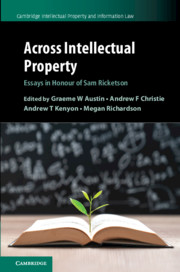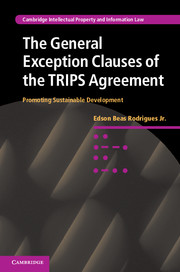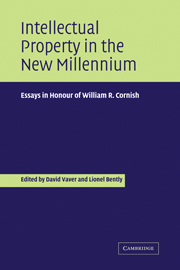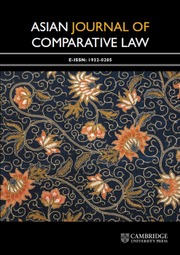Transition and Coherence in Intellectual Property Law
Essays in Honour of Annette Kur
$44.99 (F)
Part of Cambridge Intellectual Property and Information Law
- Editors:
- Niklas Bruun, Hanken School of Economics (Finland)
- Graeme B. Dinwoodie, Chicago-Kent College of Law
- Marianne Levin, Stockholm University Department of Law
- Ansgar Ohly, Ludwig Maximilian University of Munich Faculty of Law
- Date Published: July 2022
- availability: Available
- format: Paperback
- isbn: 9781108723367
$
44.99
(F)
Paperback
Other available formats:
Hardback, eBook
Looking for an examination copy?
If you are interested in the title for your course we can consider offering an examination copy. To register your interest please contact [email protected] providing details of the course you are teaching.
-
The nature and content of intellectual property (IP) law, which is heavily contingent on the state of technology and on social and market developments, has always been subject to ongoing transitions. How those transitions are effected and the shape they take is crucial to the ability of IP to achieve its stated goals and provide the necessary climate for investment in creativity, innovation and brand differentiation. Yet the need for change can run headlong into a desire for coherence. A search for coherence tests the limits of the concept of “intellectual property,” is imperiled by overlaps between different IP regimes, and calls for a unifying normative theme. This volume assembles contributors from across IP and the globe to explore these questions, including whether coherence is desirable. It should be read by anyone interested in understanding the conceptual underpinnings of one of the most important and dynamic areas of the law.
Read more- Addresses a range of pressing topics from across IP law
- Features contributions from 45 leading academics from around the world
- Identifies possible transcendental features of IP law
Customer reviews
Not yet reviewed
Be the first to review
Review was not posted due to profanity
×Product details
- Date Published: July 2022
- format: Paperback
- isbn: 9781108723367
- length: 530 pages
- dimensions: 230 x 150 x 30 mm
- weight: 0.76kg
- availability: Available
Table of Contents
Preface
Greetings to Annette Kur from the second floor
Annette Kur: toward understanding
Part I. Transition
Section 1. Forms and institutions:
1. Transitional provisions in intellectual property legislation
2. Judicial creativity and transitions in EU IP law
3. Before and after designers guild: another look at appellate deference in New Zealand's copyright law
4. EU design law: transitioning towards coherence? 15 years of national case law
5. Copyright and the CJEU – some structural deficits as seen from a german perspective
Section 2. International commitments and constraints:
6. Global intellectual property: transition and coherence through rules of interpretation
7. Article 20 of the TRIPS agreement: up in smoke?
8. Implementing international obligations at the national level
9. Multiple and overlapping transitions in IP
10. Transition and continuity in the private international law of intellectual property
11. From nintendo wii to perfumes, driving a BMW car: a tale of transition to the wrong kind of coherence
Section 3. New agents and the challenge of new technologies:
12. Transition through automation
13. Eye, robot: artificial intelligence and trade mark registers
14. Patent protection of inventions involving artificial intelligence
15. Automated profiling in new media and entertainment markets: what to protect, and how?
Part II. Coherence
Section 4. Intellectual “property” and its limits:
16. The (lack of) coherence of data ownership with the intellectual property system
17. The threefold fictitiousness of intellectual property
18. An intellectual property structural engineer extraordinaire and her lifelong quest for coherence
19. Open yet secret: trading of tangible goods and trade secrets
20. From smorgasbord to new Nordic cuisine: EU-harmonization of trade secrets protection in the Nordic countries
21. Trade mark rights and parallel imports vis-à-vis the never-ending evolution of the behavior of firms: transition and coherence put to a test
22. Legal concept of “exhaustion”: exhausted?
23. Building coherence in technological transitions: putting exploitation at the core of intellectual property
24. 'Accessory exhaustion' – and use of a work as a work
Section 5. IP overlaps:
25. Intellectual property in transition: the several sides of overlapping copyright and trademark protection
26. Cultural heritage and the public domain: what the us's myriad and mayo can teach Oslo's angry boy
27. Public order in the light of aesthetic theory – the copyright/trademark interface after vigeland
28. Separability as channeling: a cautionary tale
29. Novelty, idea or new meaning as criteria for copyright protection?: transitions in swedish design law
30. Examining functionality
31. Substantial value and the concept of shapes
32. Copyright and patents on software: the UPC's answer to an old problem of intellectual property overlaps
33. Chopping off Hydra's heads: spare parts in EU design and trade mark law
Section 6. (Un-) fairness
34. Geographical indications as intellectual property rights: beyond transition and coherence?
35. Presence or absence of coherence in trade identity protection in the European Union
36. Virtue ethics and private law – a sketch
37. Closing the gap: how EU law constrains national rules against imitation?
38. European Union law and slavish imitation – an 'update' in honour of Annette Kur
39. The german misappropriation origins of trademark antidilution doctrine: a translation of the 1924 odol opinion of the Elberfeld Landgericht
40. The relationship between the unfair competition regime and IP law
41. Comparative advertising: does trade mark law over- or under- protect the average consumer? A couple of recent examples of Asian jurisdictions going their own way
Conclusion:
42. Transition and coherence in intellectual property law.
Sorry, this resource is locked
Please register or sign in to request access. If you are having problems accessing these resources please email [email protected]
Register Sign in» Proceed
You are now leaving the Cambridge University Press website. Your eBook purchase and download will be completed by our partner www.ebooks.com. Please see the permission section of the www.ebooks.com catalogue page for details of the print & copy limits on our eBooks.
Continue ×Are you sure you want to delete your account?
This cannot be undone.
Thank you for your feedback which will help us improve our service.
If you requested a response, we will make sure to get back to you shortly.
×





